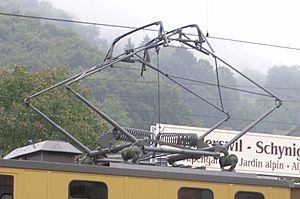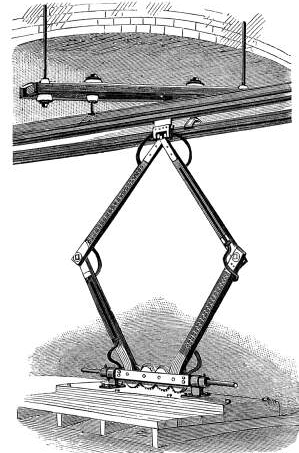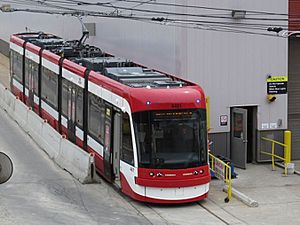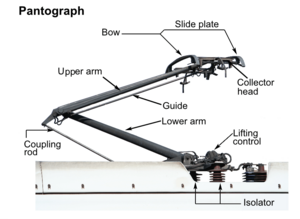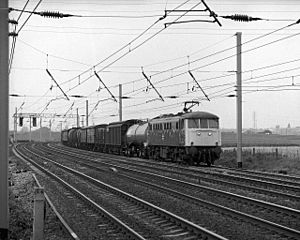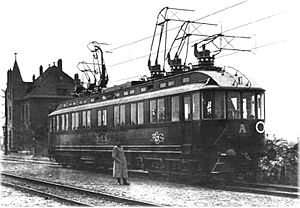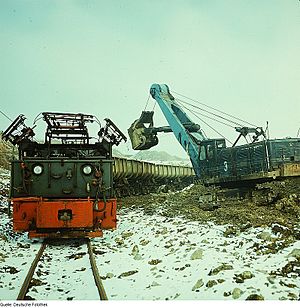Pantograph (transport) facts for kids
A pantograph is a special device found on the roof of electric trains, trams, or buses. Its main job is to collect electricity from overhead wires. This power makes the vehicle move! The name "pantograph" comes from a drawing tool that looks similar. This tool helps you copy drawings and handwriting.
Pantographs are a common way to get power for electric vehicles. They usually work with one or two overhead wires. The electricity then goes back through the metal tracks. Other ways to collect power include the bow collector and the trolley pole.
Contents
How the Pantograph Was Invented
The first pantographs appeared in the late 1800s. They had a special part, often made of graphite, that touched the wire. This part was designed to create less friction and could be replaced easily.
One early design was the bow collector, invented in 1889 in Germany. Another was a flat pantograph used in 1895 by the Baltimore & Ohio Railroad.
The familiar diamond-shaped pantograph was invented in 1903. John Q. Brown designed it for commuter trains in California. For many years, this diamond shape was used by electric train systems all over the world. Some still use it today!
The pantograph was a big improvement over the older trolley pole. It allowed electric trains to go much faster without losing contact with the overhead wires. This meant trains could travel more smoothly and reliably.
Modern Pantograph Designs
The most common type of pantograph today is the "half-pantograph." It's sometimes called 'Z'-shaped. This design was created in 1955 by Louis Faiveley. It's more compact and works better at high speeds.
You can see half-pantographs on very fast trains like the TGV. They are also used on slower city tram systems. This design works well no matter which direction the train is moving. In Europe, specific rules guide how pantographs should look and work.
How Pantographs Work
Modern electric train systems use an overhead wire system. This system has a strong upper wire called a catenary. A contact wire hangs from it. The pantograph has springs that push a special "shoe" up against the contact wire. This shoe collects the electricity needed to run the train. The metal tracks act as the path for the electricity to return.
As the train moves, the shoe slides along the wire. Sometimes, this can create waves in the wires. These waves can cause the shoe to lose contact and affect power collection. Because of this, some systems do not allow two pantographs to be used close together on the same train.
Pantographs replaced trolley poles, which were common on early streetcars. Trolley poles are still used on trolleybuses. This is because trolleybuses need more freedom to move around. Some streetcar networks also still use them, especially where there are many sharp turns. However, many of these networks are now upgrading to use pantographs.
Pantographs with overhead wires are now the main way modern electric trains get power. They allow trains to use higher voltages, even though they can be more delicate than a third rail system.
Pantographs usually work using compressed air. This air comes from the train's braking system. It either pushes the pantograph up against the wire or pulls it down. For high-voltage systems, the same air helps to "blow out" any electric sparks when safety switches on the roof are used.
Single and Double Pantographs
Pantographs can have either one arm or two arms. Double-arm pantographs are usually heavier. They need more power to raise and lower. However, they might also be more reliable if one part breaks.
In some countries, like Russia, double-arm pantographs were very common. But since the late 1990s, single-arm pantographs have also appeared there. Some streetcars still use double-arm pantographs. American streetcars typically use either trolley poles or single-arm pantographs.
Metro Systems and Overhead Lines
Most rapid transit (subway) systems get power from a third rail. But some use pantographs, especially lines that run above ground a lot. Many hybrid metro-tram lines use overhead wires. This is because a third rail would block street traffic and be too dangerous for people.
Some tram systems use a special underground power system. This system only sends power to the track sections directly under the tram. This avoids needing overhead wires, which can look out of place in historic city centers. Other similar systems use energy stored in batteries to travel short distances without wires.
Overhead pantographs are sometimes used instead of third rails. This is because third rails can freeze over in winter weather. For example, the MBTA Blue Line in Boston uses pantograph power above ground. It switches to third rail power when it goes underground.
Many metro systems around the world use overhead wiring and pantographs. These include systems in Sydney, Madrid, Barcelona, Shanghai, Hong Kong, and Seoul. Some lines in Beijing, Tokyo, and Mexico City also use them.
Some train lines use both third rail and overhead power at different points. This is often due to historical reasons. For example, some lines in London and Chicago used to switch between the two systems. However, many of these lines have now been updated to use only one system, usually the third rail, for simplicity.
Three-Phase Power
Some train systems use three-phase power. On these systems, trains might have two pantographs. The third phase of electricity comes from the running rails. In 1901, an experimental high-speed train used three overhead wires. Its collectors were mounted on pantographs that extended horizontally.
Inclined Pantographs
On train lines where open wagons are loaded from above, the overhead wire might be moved to the side. This allows cranes to load the wagons. In these cases, the pantographs are mounted at an angle to reach the offset wire.
Weaknesses of Pantographs
The part of the pantograph that touches the overhead wire is usually made of graphite. Graphite conducts electricity and also acts like a lubricant. However, graphite can be brittle. Small pieces can break off while the train is moving.
A damaged pantograph can snag the overhead wire and tear it down. Also, a damaged wire can harm the pantograph. To prevent this, special monitoring stations can check the pantographs. At very high speeds (over 300 km/h or 186 mph), friction can make the contact strip glow red hot. This can cause too many sparks and eventually lead to failure.
In the UK, pantographs are raised by air pressure. If a graphite strip breaks, air escapes. This triggers a safety device that automatically lowers the pantograph. This prevents further damage. Newer electric trains can also detect problems by sensing sparks when the graphite strips are damaged.
If a train has two pantographs, the other one can be used if one gets damaged. For example, a Class 390 'Pendolino' train has two. The pantograph at the back of the train (in the direction of travel) is often used. This is to avoid damaging both pantographs if something goes wrong with the front one.
Automatic Dropping Device
An automatic dropping device is a safety feature on electric trains. It automatically lowers the pantograph if there are obstacles or emergencies. This helps prevent accidents. This device is required for trains that travel at 160 km/h (100 mph) or faster. For slower trains, it's optional.
See also
 In Spanish: Pantógrafo (ferrocarril) para niños
In Spanish: Pantógrafo (ferrocarril) para niños
- Bow collector
- Current collector
- Pantographs and underbody collectors
- Railway electrification system
- Trolley pole


